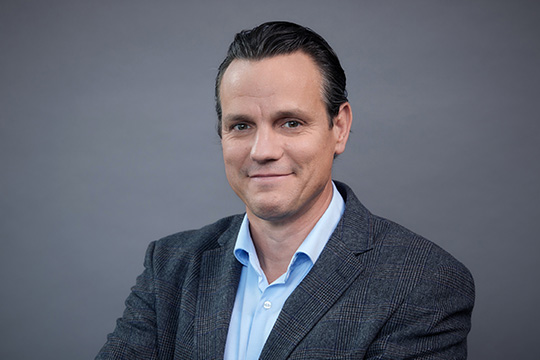Alexander Sator is the founder of the German IoT-Carrier 1NCE. The company specializes in device interconnectivity for the Internet of Things, offering companies the opportunity to connect their products across all available wireless technologies at a fixed price for ten years. Machines and devices such as energy meters as well as infrastructure, plants, fleets, and goods can be networked intelligently and easily over the course of the entire life cycle. Depending on the use case, low-power transmission technologies such as narrowband IoT or LTE-M are also available. Detecon spoke to him about challenges and solutions on the IoT market.
Detecon: Who are your customers and in what industries can the service be used?
Alexander Sator: Our customers can be found in all industries because IoT applications can be used and offer added value everywhere. Over the past three years, we have acquired 5,000 customers from all sectors and trades in record time. One major growth area, for example, is the energy and utilities sector, where providers do not stop with the interconnectivity of electricity, gas, or water meters; they are expanding to encompass other infrastructure components such as solar parks, electric charging stations, pipes, or heating systems that are made “smart” so that meters can be read and systems serviced. While this naturally saves money, it also offers better understanding of system use and capacity utilization. But IoT applications are on the rise in the logistics and automotive sectors as well. Tracking fleets and goods allows transport and movement chains to be analyzed and controlled more carefully.
Can you give us some examples of how customers benefit from using your solution?
There is a one-time charge of ten euros for our service. This price includes all — really all — costs that are typically incurred over the lifetime of an IoT application: a data volume of half a gigabyte that can be consumed over ten years, a texting allowance, the cost of the SIM card, and all use rights for our IoT platform and APIs. The customer has the advantage that no additional costs are incurred as is usually the case for roaming or the use of the platform, just to mention two examples. So the ten euros fully represent the total cost of ownership (TCO) for the connectivity. Customers will not find an offer like this anywhere but at 1NCE.
This all sounds very simple, but what happens when the half-gigabyte of data volume has been consumed?
Then the customer pays another ten euros and goes on about his business. The service remains completely transparent and calculable. You pay only for what you actually use and you are not tied for years to contracts that have proven in retrospect to be far too expensive or, conversely, inadequate.
Why did you found 1NCE?
To put it succinctly, I would say: timing. I’ve been active on the Internet of Things market for over 25 years; it just wasn’t called that back then. When we launched 1NCE 3½ years ago, no service like ours was to be found anywhere. If customers wanted to interconnect an IoT solution, they had to go to a wireless carrier who offered a rate plan based on a monthly fee. The problem with this approach: a majority of the applications on the IoT market are inadequately served, if at all, because the costs are too high, too complicated, and too opaque as well. We have changed that completely with 1NCE and offer complete service based on a single, low-cost rate that provides full cost transparency for ten years: the IoT flat rate.
Are there any current trends in the market that you are responding to from the supply side?
That requires understanding what we actually cover with 1NCE. Strictly speaking, there are two primary areas: the provision and integration of connectivity and the handling of data transport. Both of these areas are subject to a fast level of technological change, but we are not satisfied just to keep pace with the changes — we also develop new services. As far as providing the service is concerned, we have staked out our course so that in future everything will be software-based as far as possible. That means we are already working on providing connectivity as a software to customers.
Connectivity as a software — how can we picture that?
Our product can be purchased online today, for example, on the AWS Marketplace as well as in our own store. So customers already running their solutions in the AWS cloud don’t even have to leave their familiar environment. But there’s more: in the future, we will be pre-installed as a provider on many IoT devices and so be directly usable — in some cases, we will no longer be visible at all, but instead part of a larger whole.
The other major area that is at the focal point of our ongoing work is the improvement of data transport itself. Concurrently with the launch of 1NCE, we developed our own network platform with completely software-based operation in the cloud. This gives us the ability to respond flexibly and, above all, quickly to market requirements — for example, for globally operating customers who roll out instances of our platform in data centers close to their customers in a matter of only a few weeks.
How long does it typically take a company to go from initial concept to rollout of an IoT project?
All the buzz around IoT can often distract us and cause us to forget the important fact that this is a complex market where a number of technology worlds collide; for 1NCE customers, these are usually the worlds of IT and telecommunications. The latter was long dominated by hardware and still requires a high level of expertise, whether for connecting a radio module to the network or configuring the network correctly. The IT side, i.e., setting up the solution as such, is no less complex as it is a matter of striking the right balance between technical effort and the added value that can be generated. It's not uncommon for us to see customers taking up to 18 months to develop a solution to the rollout phase.
But this is exactly where 1NCE comes in — our service package of ten euros per connection includes numerous features that help customers to save as much as 50 to 60 percent of the typical project implementation time. On average, customers using our service require only about six to seven months.
What features are crucial for the time savings you mentioned?
Off the top of my head, I can think of three important features that customers I talk to value highly. For one, there is no minimum order quantity. Sounds banal initially — but the advantage for customers is that they can order when the need arises. Since we ship directly from stock, the customers’ assemblers have the cards after only two to three days. This type of service was previously unavailable to customers — minimum order quantities, purchase commitments, and delivery times of six weeks and longer were commonplace.
Moreover, all our cards are pre-activated from stock, which means that customers do not have to enter a PIN or PUK anywhere. Imagine having to do this for 10,000 devices at once — that is not something that you can do in your spare time, and the process often took some weeks at the customer sites as additional work-arounds had to be developed for this purpose.
Finally, I have listened to many a CTO bemoaning the cumbersome procedures for registering a fleet of devices with a thousand connections in the cloud environment. Here as well, lengthy tokens had to be entered in a tedious and time-consuming process before a device was even securely authenticated in the cloud. We have incorporated the security token into the SIM card, and the cloud automatically recognizes the devices when they log in.
What do companies/municipalities currently lack when they use IoT (conceptually, technologically)?
This is difficult to answer on a general level as our customers sometimes bring widely different competencies to the table. This varies a little from one industry to the next — but overall, we usually see a highly heterogeneous field. I would say that this is because our product is very easy to access and so it addresses an extraordinarily broad range of business customers. But of course we see which customers are successful and can also draw some conclusions as to why they succeed in implementing their IoT projects. One key factor for success is the choice of the right partners. It is extraordinarily difficult to cover all areas of added value in IoT, which is why it is usually worth consulting the pertinent experts at each point along the chain. For example, we limit ourselves to connectivity — this is where we are the experts. You don’t have to reinvent everything; instead, you can draw on approaches and experience that have already been tried and proven.
How would you describe the current positioning of German cities in general in terms of the smart city? What would you like to see?
Our connectivity is already being used in many infrastructure projects such as “smart street lighting” or electric charging stations. A lot is happening in this field right now. There are municipalities and cities that are particularly well positioned in this regard and that have also successfully completed pilot projects. From my point of view, it will be exciting to see how the mass rollout progresses. I think we will have to be patient for a while yet because the completion of the coordination and approval process will take a little longer. However, I clearly see impetus coming from small and midsize enterprises — there are plenty of innovative companies emerging here that are developing and indeed have developed clever as well as affordable solutions, in no small part thanks to our low-cost and simple service.
In which fields of application would you say that narrowband IoT (NB-IoT) technology has proved itself with especially impressive results?
NB-IoT is a comparatively new radio technology — especially considering the amount of time customers have been making any practical use of it at all. Nevertheless, we see the benefits always coming to the fore whenever an application requires only a low data volume or high building penetration. The prime example is smart meters — customers take advantage of NB-IoT’s so-called coverage extension. But the lower cost of the radio modules is also attractive, so application areas with somewhat higher data volumes such as digital price tags or asset tracking are also using NB-IoT. By the way, LTE-M is attractive as an alternative wherever higher bandwidths are required in addition to low energy consumption. Long operating periods of battery-powered devices can also be achieved this way. In the ideal case, however, data can be transferred as much as eight times faster.
Thank you for the interview!







